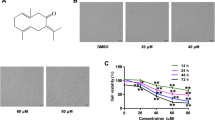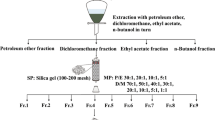Abstract
The Monascus pigment, rubropunctatin, was extracted and purified from red mold rice (RMR) and its cytotoxic activities against human gastric adenocarcinoma BGC-823 cells were studied both in vitro and in vivo. Rubropunctatin inhibited the proliferation of BGC-823 cells with an inhibitory concentration (IC50) of 12.57 μM, while it exhibited no significant toxicity to normal gastric epithelial cell GES-1 at the same concentration. Treatment of BGC-823 cells with rubropunctatin resulted in a dose- and time-dependent apoptosis, as validated by the increase in the percentage of cells in sub-G1 phase and phosphotidylserine externalization. The in vivo experimental data demonstrated that rubropunctatin could offer similar therapeutic benefits in comparison with the same dose of taxol. After five times of intravenous injection, tumor weight in BGC-823-bearing nude mice reduced 23.5% at the dose of 8 mg/kg and 37.7% at the dose of 32 mg/kg, respectively. The expressions of 30 genes related to induction of apoptosis were found up-regulated significantly. The two most expressed genes were tumor necrosis factor (TNF) and DNA-damage inducible transcript 3. TNF was considered as a major mediator of apoptosis induced by rubropunctatin. This is the first report describing the anti-proliferative effect of rubropunctatin and its apoptosis mechanism on BGC-823 cells. Rubropunctatin has potential to be developed as a new natural anti-cancer agent.





Similar content being viewed by others
References
Akihisa T, Tokuda H, Yasukawa K, Ukiya M, Kiyota A, Sakamoto N, Suzuki T, Tanabe N, Nishinos H (2005) Azaphilones, furanoisophthalides, and amino acids from the extracts of Monascus pilosus-fermented rice (red-mold rice) and their chemopreventive effects. J Agric Food Chem 53(3):562–565
Altmann K, Gertsch J (2007) Anticancer drugs from natural products as a unique source of new microtubule-stabilizing agents. Nat Prod Rep 24(2):327–357
Chang Y, Li L, Wu C, Liu T, Lui W, Peng F, Chi C (1998) Paclitaxel-induced apoptosis in human gastric carcinoma cell lines. Cancer 77(1):14–18
da Rocha A, Lopes R, Schwartsmann G (2001) Natural products in anticancer therapy. Curr Opin Pharmacol 1(4):364–369
Ho B, Pan T (2009) The monascus metabolite monacolin K reduces tumor progression and metastasis of Lewis Lung carcinoma cells. J Agric Food Chem 57(18):8258–8265
Hong M, Seeram N, Zhang Y, Heber D (2008) Anticancer effects of Chinese red yeast rice versus monacolin K alone on colon cancer cells. J Nutr Biochem 19(7):448–458
Jemal A, Murray T, Ward E, Samuels A, Tiwari R, Ghafoor A, Feuer E, Thun M (2005) Cancer statistics, 2005. CA Cancer J Clin 55:10–30
Jůzlová P, Martinkova L, Ken V (1996) Secondary metabolites of the fungusMonascus: a review. J Ind Microbiol Biotechnol 16(3):163–170
Kalaivani M, Sabitha R, Kalaiselvan V, Rajasekaran A (2010) Health benefits and clinical impact of major nutrient, red yeast rice: a review. Food Bioprocess Technol 3(3):333–339
Lin Y, Wang T, Lee M, Su N (2008) Biologically active components and nutraceuticals in the Monascus-fermented rice: a review. Appl Microbiol Biotechnol 77(5):965–973
Musso L, Dallavalle S, Merlini L, Bava A, Nasini G, Penco S, Giannini G, Giommarelli C, Cesare AD, Zuco V, Vesci L, Pisano C, Piaz FD, Tommasi ND, Zunino F (2010) Natural and semisynthetic azaphilones as a new scaffold for Hsp90 inhibitors. Bioorganic Med Chem. doi:10.1016/j.bmc.2010.06.068
Osmanova N, Schultze W, Ayoub N (2010) Azaphilones: a class of fungal metabolites with diverse biological activities. Phytochem Rev 9(2):315–342
Su N, Lin Y, Lee M, Ho C (2005) Ankaflavin from monascus-fermented red rice exhibits selective cytotoxic effect and induces cell death on hep G2 cells. J Agric Food Chem 53(6):1949–1954
Yasukawa K, Akihisa T, Oinuma H, Kaminaga T, Kanno H, Kasahara Y, Tamura T, Kumaki K, Yamanouchi S, Takido M (1996) Inhibitory effect of taraxastane-type triterpenes on tumor promotion by 12-O-tetradecanoylphorbol-3-acetate in two-stage carcinogenesis in mouse skin. Oncology 53(4):341–344
Zheng Y, Xin Y, Guo Y (2009) Study on the fingerprint profile of Monascus products with HPLC-FD PAD and MS. Food Chem 113(2):705–711
Zhou H, Zhu J (2003) Paclitaxel induces apoptosis in human gastric carcinoma cells. World J Gastroenterol 9(3):442–445
Acknowledgment
The authors are grateful for funds provided by the Fujian Key Lab of Medical Instrument and Pharmaceutical Technology, China (No. 09002).
Author information
Authors and Affiliations
Corresponding author
Rights and permissions
About this article
Cite this article
Zheng, Y., Xin, Y., Shi, X. et al. Anti-cancer effect of rubropunctatin against human gastric carcinoma cells BGC-823. Appl Microbiol Biotechnol 88, 1169–1177 (2010). https://doi.org/10.1007/s00253-010-2834-6
Received:
Revised:
Accepted:
Published:
Issue Date:
DOI: https://doi.org/10.1007/s00253-010-2834-6




